Sorted by date Results 126 - 147 of 147

Among the memorials in the Anchorage Municipal Park Cemetery stands a small, pink marker adorned with a palette. It is the final resting place of Sydney Mortimer Laurence, one of Alaska's greatest artists. Known for his dramatic landscape paintings, Laurence was one of the first professionally trained artists to live in the territory. His works, which often feature Mt. McKinley, hang in the Musee du Louvre in Paris, the National Art Gallery in Washington, D.C. and many other locations worldwide....

One of Anchorage's most respected doctors made a mercy run to Iditarod four years before Nome's celebrated diphtheria serum run of 1925. Early on the morning of Jan. 24, 1921, Dr. John B. Beeson hopped on a train leaving Anchorage and headed toward Iditarod after getting word through the U.S. Army Signal Corps that Claude Baker was near death. Baker, a well-known Iditarod banker, was suffering from an old injury he'd received while serving as a guard on the gold trail outside the famous mining...
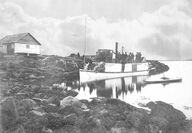
Some courageous pioneers saw the possibilities of the Yukon Basin years before the Klondike Gold Rush. And a few stand out above the rest, including Leroy Napoleon "Jack" McQuesten, Alfred Mayo and Arthur Harper. Had they not seen the need to establish supply centers, it is possible that gold rushes to the Yukon and Alaska would not have boomed during the late 1890s. These men met up in British Columbia in 1873 and continued on to Fort Yukon together. The first winter, Harper went prospecting...
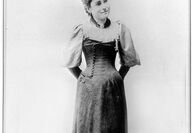
Mollie Walsh made a name for herself among the prospectors who flooded north during the Klondike Gold Rush. Her "grub tent" was a welcome sight to many miners who climbed the White Pass Trail in the late 1890s. One man carried such affection for her that he created a memorial that still stands today in the little town of Skagway. Born Mary Walsh in 1872, the Irish lass had packed her bags and headed north from Montana in 1897. Various sources say she was a dancehall girl in Butte, worked for an...
When Alaska was transferred from Russia rule to the United States, it was up to the Americans to establish a way to deliver mail across its new possession. The Russians had not used a postal system. Communications between Russia and Russian America was handled by dispatch cases transported by Russian supply ships. Russian residents sent and received both business and personal mail through the Russian commanders in their communities. Three months before Alaska was formally handed off to American rule, the first post office in the northern...

While workers completed the last portion of the Alaska-Canada Highway at Beaver Creek on Oct. 25, 1942, the idea to connect Alaska to the rest of the world was born many years earlier. Donald MacDonald, a locating engineer with the Alaska Road Commission, had dreamed for years of an overland coastal route to Alaska. It would run north from Seattle across British Columbia through the Yukon Territory to Fairbanks. MacDonald and a group of Fairbanks residents formed the International Highway...
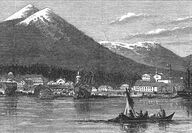
Russian fur traders wanted to build a fort called Mikhailovsk about six miles north of the present town of Sitka in 1799. They gave the Tlingits, who'd occupied that part of Southeast Alaska for more than 10,000 years, beads and other trading goods in exchange for a small piece of land. The Native people at first thought the Russians might be good trading partners. But soon they realized they'd made a bad deal with Alexander Baranof, chief manager for the Russian-American Company. Submission to...
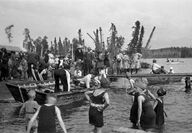
The section of Anchorage called Spenard was referred to as the "Miracle Mile" not so long ago. As part of the Chugach National Forest created by U.S. President Teddy Roosevelt in 1907, the land was locked in a government deep freeze for several years. When the residents of the Alaska Railroad camp asked that the land surrounding the new town be unshackled in 1919, the government lifted its restrictions on the property. The growth of Anchorage to the south could not have happened if this...
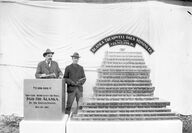
A gambler's hunch compelled California mining magnate John Treadwell to purchase a claim from "French Pete" for $400. That decision turned into the discovery of the famed "Glory Hole" on Douglas Island in Southeastern Alaska in 1881. Gold had been discovered in the Silver Bow Basin near Juneau in October 1880. Joe Juneau and Richard Harris, along with Sitka chief Kowee, had trekked through moss, slippery rocks and devil's club to get to a place the Tlingits called Bear's Nest. "It was a...

Long before the Matanuska Valley became one of the fastest-growing communities in the nation, Russians tried to establish agricultural settlements on its fertile soil. They taught the Tanaina how to grow crops like potatoes, carrots, radishes and turnips. In 1844, Russians founded settlements at Matanuska and Knik, as well as Kachemak, Kasilof and Kenai. "A handful of Cossacks and a few hundred homeless mujiks [peasants] crossed oceans of ice at their own risk, and wherever timeworn groups of th...
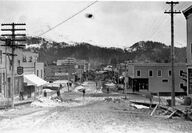
At 4 a.m. on May 2, 1963, Cordovans awoke to the sounds of fire sirens wailing through their streets. Then came a bombardment of ammunition as shells exploded in the basement of the Cordova Commercial Co., the town's largest store. Six charges of dynamite, set off in an attempt to check the fire, broke windows all over town. But the fire did not stop until 14 buildings had been destroyed and more than 125 men, women and children were left homeless. At the height of the excitement, everyone was t...

Have you ever wondered what it was like living in "the good old days" and wished you could step back in time? One Anchorage home listed on the National Register of Historic Places offers visitors that opportunity and showcases the furniture, appliances and gadgets from days gone by. The Oscar Anderson House Museum, located at 420 M Street, is filled with memorabilia from the turn-of-the-last century. Built in 1915, it's the first frame house constructed in Anchorage and belonged to the...

"Standing here and looking far off into the northwest, I see the Russian as he busily occupies himself in establishing seaports and towns and fortifications on the verge of the continent...and I can say, 'Go on and build up your outposts all along the coast, up even to the Arctic Ocean; they will yet become the outposts of my own country – monuments of the civilization of the United States in the northwest.' " So predicted U.S. Secretary of State William H. Seward in a speech many years b...

Cordova's Iceworm, the brain child of Ohmer Waer in 1960, was a gallant effort to attract tourists to Cordova and combat midwinter doldrums. Waer, manager of the historic old Windsor Hotel, looked around the empty lobby one fall morning as he drank a cup of coffee. "What this town needs is an iceworm," he told his wife. Of course, Waer didn't mean a real iceworm. Discovered in 1887 on the Muir Glacier, that annelid worm spends its entire life in glacial ice in Alaska, Washington, Oregon and...
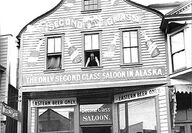
Many hardy gunslingers and prospectors who made Tombstone a household word in the late 1800s, landed in Alaska and the Yukon after the demise of the Arizona city. One of the most famous was Wyatt Earp. Earp arrived in the north during the height of the Alaska gold rush in Nome. But he didn't go there to mine for gold. He'd fled Arizona under indictment for murder after the notorious massacre of the Clantons at the OK Corral and the shooting of Frank Stillwell. A letter found in the basement of...
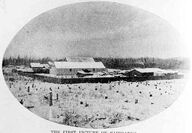
Felix Pedro joined the Klondike rush in 1898 from the Carbonado coalmines in Washington state. But his lucky number failed to come up, so he and Frank Costa, another Italian prospector, wandered over into the valley of the Tanana to prospect its streams and creeks. Deviled by mosquitoes, and forced at times to eat some of their dogs, they traveled through the wooded valleys, climbed the rugged hills and faced moose and grizzly bears. In July 1902, Pedro struck gold on a small stream just 24...
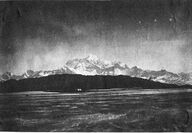
Mount Saint Elias, the first point sighted by white man on the mainland of Alaska in 1741, has proved a mighty challenge to mountaineers. The second highest peak in the United States, behind Mount McKinley, and the fourth highest peak in North America, it is 18,008 feet high. Situated on the Yukon and Alaska border, only a handful of climbers have conquered it in the 261 years since Vitus Bering discovered and named it. The mountain's name in Tlingit is Yaas'éit'aa Shaa, which means "mountain...
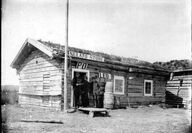
John Clum, the colorful editor of the widely known “Tombstone Epitaph,” made his mark on Alaska in the late 1890s. He was appointed post office inspector for the territory in March 1898. He and his son, Woodworth, traveled 8,000 miles around Alaska and the Yukon setting up new post offices and equipping others. It was no job for a weakling – one of his inspection trips was made on “foot and in a snowstorm” to Chilkat, and a second trip, according to his diary, was via reindeer and “lap” sle...
Cordova made national headlines when its citizens took a leaf from the annals of Boston. But instead of a tea party, they staged a coal party. They proved to a far away and indifferent government that the spirit of ’76 was still alive on May 11, 1911. Five years before, a campaign for the conservation of natural resources swept America, and the government decided to withdraw the coal, oil and timber lands of Alaska from private ownership. The Copper River Railroad stopped building its branch line to the Bering River coal fields. Katalla, w...

When rescuers arrived on the scene of an airplane crash near Point Barrow on Aug. 15, 1935, they found humorist Will Rogers dead. A typewriter recovered in the wreckage had Rogers’ unfinished last “piece for the papers,” and the final word he’d typed was “death.” But Rogers didn’t seem to have had a premonition that his trip to Alaska would end in disaster. In an interview in Portland, Ore., a short time before the tragedy, he was asked, “When are you going to write a book on your life?” “I...
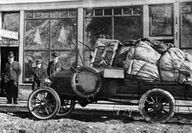
One of Alaska’s trailblazers made history 100 years ago this month. Robert E. “Bobby” Sheldon made the first automobile trip over the wagon trail from Fairbanks to Valdez in July 1913. Sheldon had another first before that feat. He built the first automobile in Alaska. Sheldon and his father arrived in Skagway from Snohomish, Wash., in 1883, on their way to the Klondike gold fields. However, Sheldon’s father died and left him to fend for himself at the age of 14. The boy survived by selling...
An unofficial head count taken at Sitka by the U.S. Army in 1869 revealed 391 civilians made up the town’s population, which included 10 saloonkeepers and 29 prostitutes. It was hoped that the 1880 Census would elevate Alaska’s image. Chosen to take the important tally was one of the most controversial figures in Alaska history, Ivan Petroff. Years later, historians would say Petroff was everything from a “Prevaricator Par Excellence” and able historian, to a three-time Army deserter, falsifier of documents and “teller of tall tales.” P...